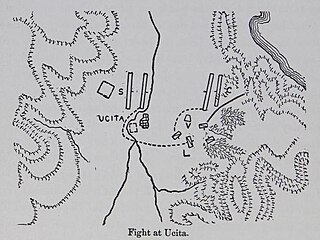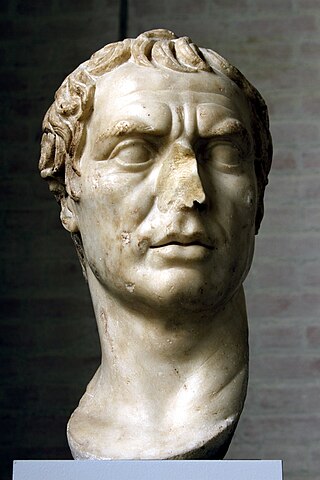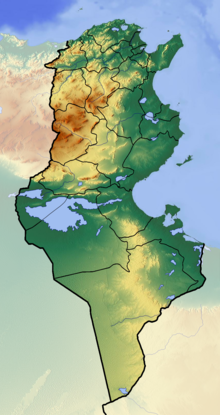Year 49 BC was a year of the pre-Julian Roman calendar. At the time, it was known as the Year of the Consulship of Lentulus and Marcellus. The denomination 49 BC for this year has been used since the early medieval period, when the Anno Domini calendar era became the prevalent method in Europe for naming years.
Year 203 BC was a year of the pre-Julian Roman calendar. At the time it was known as the Year of the Consulship of Caepio and Geminus. The denomination 203 BC for this year has been used since the early medieval period, when the Anno Domini calendar era became the prevalent method in Europe for naming years.
Gaius Asinius Pollio was a Roman soldier, politician, orator, poet, playwright, literary critic, and historian, whose lost contemporaneous history provided much of the material used by the historians Appian and Plutarch. Pollio was most famously a patron of Virgil and a friend of Horace and poems to him were dedicated by both men.

The Battle of Thapsus was a military engagement that took place on April 6, 46 BC near Thapsus. The forces of the Optimates, led by Quintus Caecilius Metellus Scipio, were defeated by the forces of Julius Caesar. It was followed shortly by the suicides of Scipio and his ally, Cato the Younger, the Numidian king Juba, and his Roman peer Marcus Petreius.

Juba I of Numidia was a king of Numidia who reigned from 60 to 46 BC. He was the son and successor to Hiempsal II.
Publius Attius Varus was the Roman governor of Africa during the civil war between Julius Caesar and Pompey. He declared against Caesar, and initially fought Gaius Scribonius Curio, who was sent against him in 49 BC.
The Battle of the Muthul was fought at the Muthul River in Numidia in 109 BC. The Numidians, led by their king Jugurtha, fought a Roman army commanded by the consul Quintus Caecilius Metellus Numidicus. The battle was fought during the Jugurthine War, a war between King Jugurtha of Numidia and the Roman Republic. The battle was indecisive - it took the Romans four more years to defeat Jugurtha. Jugurtha was eventually captured by Lucius Cornelius Sulla in 105 and executed during Marius' Triumphal parade a year later (104). The Roman historian Publius Rutilius Rufus distinguished himself during the battle, while Gaius Marius' military genius shone through for the first time, saving the day for the Romans.

Commentarii de Bello Civili(Commentaries on the Civil War), or Bellum Civile, is an account written by Julius Caesar of his war against Gnaeus Pompeius and the Roman Senate. It consists of three books covering the events of 49–48 BC, from shortly before Caesar's invasion of Italy to Pompey's defeat at the Battle of Pharsalus and flight to Egypt. It was preceded by the much longer account of Caesar's campaigns in Gaul and was followed by similar works covering the ensuing wars against the remnants of Pompey's armies in Egypt, North Africa, and Spain. Caesar's authorship of the Commentarii de Bello Civili is not disputed, while the three later works are believed to have been written by contemporaries of Caesar.

The Battle of Utica in Caesar's Civil War was fought between Julius Caesar's general Gaius Scribonius Curio and Pompeian legionaries commanded by Publius Attius Varus supported by Numidian cavalry and foot soldiers sent by King Juba I of Numidia. Curio defeated the Pompeians and Numidians and drove Varus back into the town of Utica.

Leptis or Lepcis Parva was a Phoenician colony and Carthaginian and Roman port on Africa's Mediterranean coast, corresponding to the modern town Lemta, just south of Monastir, Tunisia. In antiquity, it was one of the wealthiest cities in the region.

The battle of the Great Plains was fought in 203 BC in modern Tunisia between a Roman army commanded by Publius Cornelius Scipio, and allied Carthaginian and Numidian armies commanded by Hasdrubal Gisco and Syphax respectively. The battle was part of the Second Punic War and resulted in a heavy defeat for Carthage.
The Battle of Cirta was fought in 203 BC between an army of largely Masaesyli Numidians commanded by their king Syphax and a force of mainly Massylii Numidians led by Masinissa, who was supported by an unknown number of Romans under the legate Gaius Laelius. It took place somewhere to the east of the city of Cirta and was part of the Second Punic War. The numbers engaged on each side and the casualties suffered are not known.

The siege of Utica was a siege during the Second Punic War between the Roman Republic and Carthage in 204 BC. Roman general Scipio Africanus besieged Utica, intending to use it as a supply base for his campaign against Carthage in North Africa. He launched repeated and coordinated army-navy assaults on the city, all of which failed. The arrival of a large Carthaginian and Numidian relief army under Carthaginian general Hasdrubal Gisco and Numidian king Syphax in late autumn forced Scipio to break off the siege after 40 days and retreat to the coast.

The battle of Utica was fought in 203 BC between a Roman army commanded by Publius Cornelius Scipio and the allied armies of Carthage and Numidia, commanded by Hasdrubal Gisgo and Syphax respectively. The battle was part of the Second Punic War and resulted in a heavy defeat for Carthage.
Arabio was the last independent Numidian king, ruling the western region between 44 and 40 BC. According to Appian, he was a son of Masinissa II and probable grandson of Gauda, who had divided Numidia between his sons in 88 BC. He was of Massylian origin.
The Second Battle of Cirta, part of the Jugurthine War, was fought in 106 BC between a Numidian-Mauretanian coalition and a Roman army near the Numidian capital of Cirta. The Numidians were led by King Jugurtha, the Mauritanians were led by king Bocchus while the Romans were under the overall command of Gaius Marius who was supported by his quaestor Lucius Cornelius Sulla as cavalry commander. The Romans were victorious routing their opponents and capturing Cirta.
Gaius Scribonius Curio was the son of Gaius Scribonius Curio and consul in 76 BC. His political allegiances changed over the course of the 50s BC until his tribunate, when he sided with Julius Caesar after possibly receiving a massive bribe. During the civil war, he sided with Caesar and led Caesarian troops to Sicily and then to Africa, where he was killed in battle.
The Battle of Hippo Regius was a naval encounter during Caesar's Civil War which occurred off the coast of the African city of Hippo Regius in 46 BC. Metellus Scipio and a number of influential senators from the Optimate faction were fleeing the disastrous Battle of Thapsus when their fleet was intercepted and destroyed by Publius Sittius, a mercenary commander in the employ of the Mauretanian king Bogud, an ally of Gaius Julius Caesar's. Scipio committed suicide and all of the other senators were killed during the battle.
Saburra was a Numidian general who served the king of Numidia, Juba I, and fought Julius Caesar during Caesar's Civil War. He managed to defeat one of Caesar's lieutenant, Gaius Scribonius Curio at the Battle of the Bagradas before eventually being killed in battle by a mercenary commander Publius Sittius, who was loyal to Caesar.
The Battle off Carteia was a minor naval battle during the latter stages of Caesar's civil war won by the Caesarians led by Caesar's legate Gaius Didius against the Pompeians led by Publius Attius Varus.








